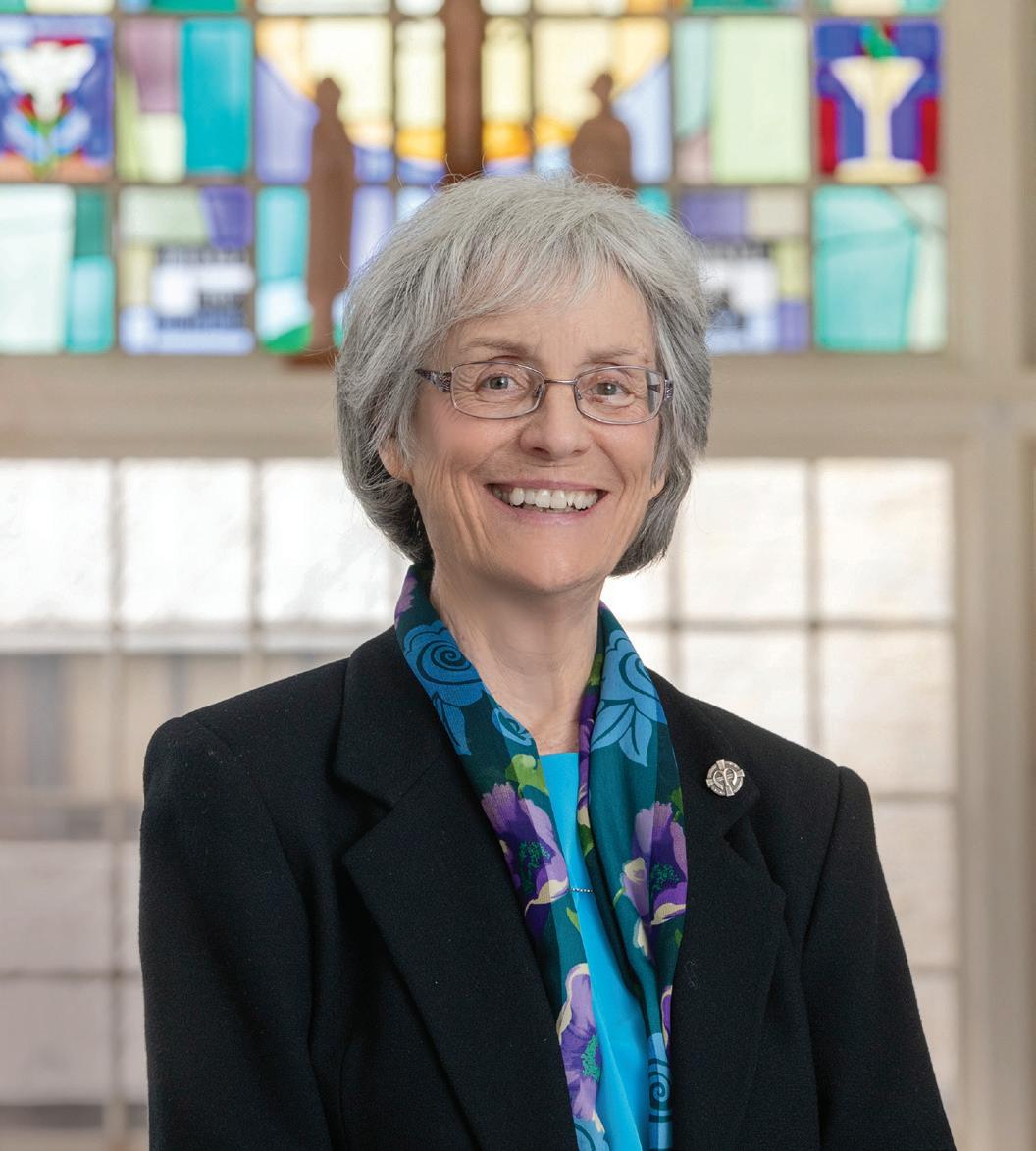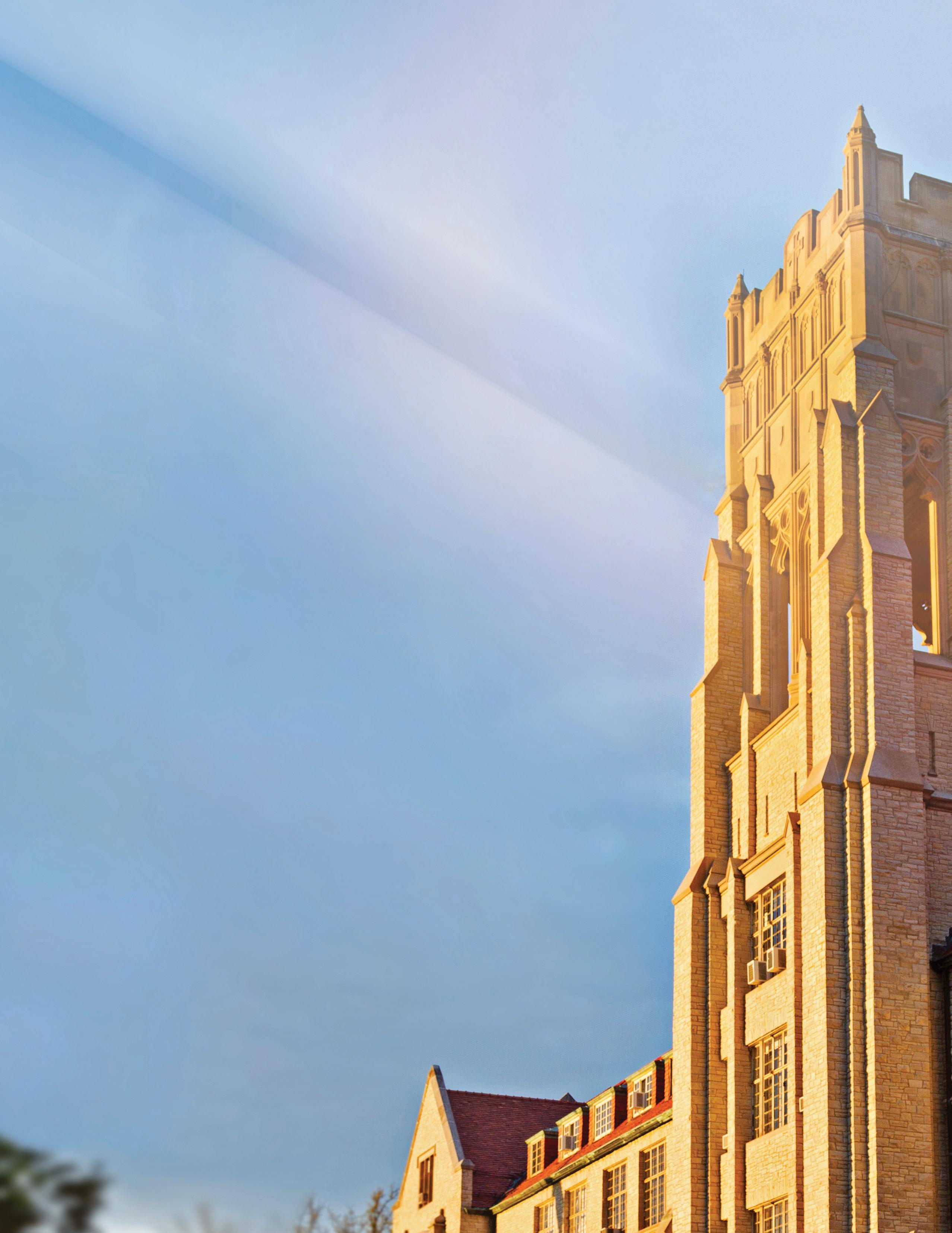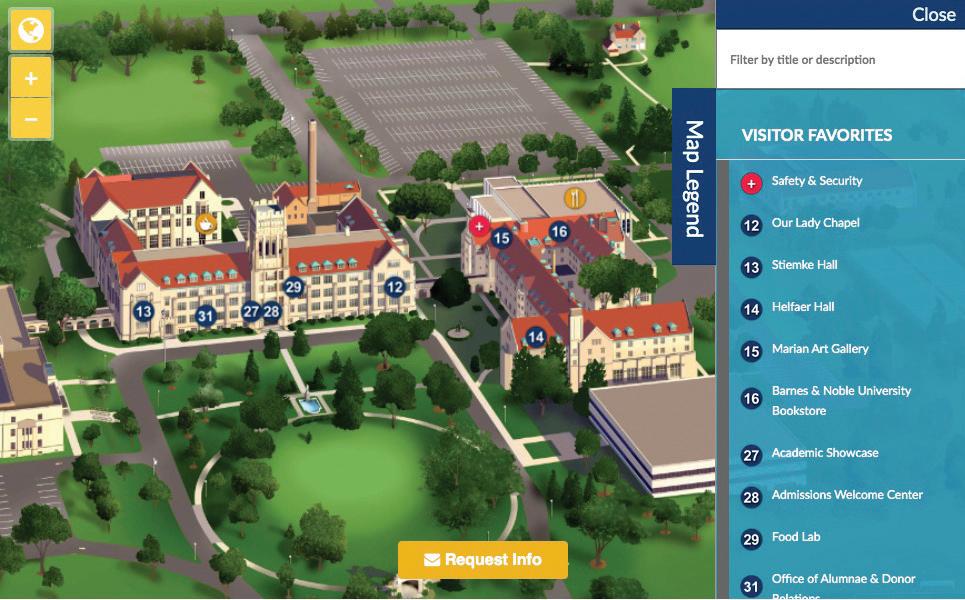
18 minute read
From the President
Dear Mount Mary Alumnae and Friends,
We are making history! They say that history is told through the lens of the author and certainly we know that to be true based upon historical records where many uncomfortable truths are omitted. As I reflected upon the last eight months while preparing for this magazine, I am struck by the multitude of perspectives that this magazine will present about our current situation and yet I wonder what perspectives we are missing. In these challenging days we are searching to ensure we are part of portraying the truth. Certainly we are living in unparalleled times. Some have named it the age of two pandemics: COVID-19 and racism. Regardless of your perspective, this time has challenged the university in ways we have not previously encountered and has called upon us to think and act with new and inventive approaches. In many ways, it has been a truly humbling experience. As we strive to meet our students’ learning needs while keeping them healthy and safe, the creative nature of our faculty and staff has been admirable and determined as is described in the article on coronavirus and campus adaptations (page 6). As the issues of racism have become increasingly visible in the Midwest, our state and the very neighborhood of Wauwatosa surrounding our campus, we have grown in our desire for reflection, discussion and a need to truly address issues of inequity and injustice in our society in alignment with the core values instilled in our institution by our founders, the School Sisters of Notre Dame. The article, “Our Quest for Equity,” on page 4 details some of our successes, but much work remains to remove all barriers for people of color. During these past months many students and employees have struggled with both of these pandemics, however, there are some silver linings becoming apparent. What have we discovered? We have learned that we are far more adaptable than we realized when it comes to serving our students. We developed
FROM PRESIDENT
and implemented new technologies and teaching methodologies that would have taken months or years under more “normal” circumstances. We have created broader and deeper safety nets for students than those that were already present. By that, I mean financial, academic, technological and emotional safety nets. We have found and utilized extensive communication to keep people informed — email, text messages, announcements, Zoom, Skype, Teams and the list goes on! We have realized we can do a lot of work from home and still stay connected as individuals and as a community. We have effectively engaged students in addressing our challenges through new types of work study positions. And perhaps most importantly, I believe we have grown as a community, which sometimes happens during difficult times. Seldom have I seen people work so hard to serve and support students and each other. Rarely have I observed so many selfless gifts of time, talent and treasure. Not only those people on campus, but our larger community of alumnae, friends and our Board of Trustees have provided tremendous support to Mount Mary through these challenging times. The outcome is that we are going to emerge stronger and more resilient than ever. These pandemics have prepared us to be more versatile educators, more empathetic and united to our students and employees of color, better communicators and more creative problem-solvers. I have never been more proud to be the President of Mount Mary University than I am today. I am exceedingly grateful to our campus community and our commitment to one another. These unparalleled times will ultimately serve us well as we humbly seek to transform lives though education and service to each other. With gratitude,

Unity in diversity is at the heart of our SSND mission. We commit to building an inclusive environment that promotes unity in a divided world. Our quest for equity

United by common values, we navigate difficult times together
In times of hardship and uncertainty, it’s areas of progress of we’ve made in the areas of diversity, invaluable to have a cornerstone to revisit, equity and inclusion and share our vision for the future. both as a source of strength and as a vision for the future. As racial inequality, social injustice and the oppression of marginalized communities continue to occur across the nation, we return to our foundation. Now more than ever, our core values of competence, community, compassion and commitment have been the guideposts in remaining true to our mission and relevant in an ever-changing world. These values enable us to foster a learning environment that welcomes and celebrates students from diverse backgrounds. Today, 58 percent of our undergraduate students identify themselves as ethnically diverse. This spring, Mount Mary became a designated HispanicServing Institution, a classification by the U.S. Department of Education based upon an COMPETENCE: STAYING INFORMED Effective change requires a certain level of knowledge about social issues. Knowledge then becomes the bridge to empathy, understanding and ultimately, justice. Students are introduced to these concepts in the Leadership for Social Justice Seminar (LSJ), a course that first-time undergraduate students are required to take during their first year. LSJ reviews issues of oppression and privilege, spanning across sexism, racism, classism, religious oppression, heterosexism, trans oppression, as well as youth and elder oppression. Students learn about the intersectionality of issues and analyze the viability of proposed solutions. In the employee realm, faculty members receive ongoing education and training on inclusive and equitable teaching, covering topics such as microagressions in curriculums to equitable test-taking practices. institution’s ability Inclusive Excellence Curriculum Specialist, to enroll and serve Aza Baylor, Ph.D., guides faculty through at least 25% Latinx trainings to learn about the social and undergraduate historical context of exclusionary students. practices in higher education in the U.S. Peace Vigil, June 2020 Using our values as a lens, we highlight Her work is funded through a grant from the Howard Hughes Medical Institute. This grant also funds ongoing professional

development programming. Past discussions have included Milwaukee’s civil rights history, the historical and sociopolitical context of Latinx Milwaukee, and the health disparities affecting LGBTQ youth and young adults. An important contributor to community knowledge is the Haggerty Library. In response to racial injustices, the library staff recently compiled and continues to curate a list of antiracist resources. Library staff members are also committed to updating collections to be more inclusive, and the staff works closely with faculty to inform them of diverse options that can supplement their curricula. “While MMU is making headway on issues of diversity, equity and inclusion, we would do well to continue our efforts as lifelong learners,” said Jason Meyler, Ph.D., an assistant professor and chair of the World Languages Department. “The fact that there is much more to do with our time on earth should not impede us from working harder right now.” COMMUNITY: WELCOMING ALL A sense of community and connection is as important as ever during these times that may leave us feeling isolated and alone. Shortly after the death of George Floyd, the Mount Mary community came together to hold a peace vigil for change, equity and justice. Over 70 individuals from all parts of campus gathered to advocate for change. Another response to the increased visibility of social and racial injustices this year is the development of reoccurring, campus-wide internal discussions. Community members have also created their own discussion groups and book clubs. President Christine Pharr, Ph.D., also held a listening session with student leaders from Spectrum (LGBTQIA+), Black Student Union, Hispanic Professionals of Greater Milwaukee (HPGM), Asian Student Organization and Students Achieving Leadership through Spanish Activities (SALSA). All discussions are held with the desire to learn how best to serve one another. These acts of community are aligned with efforts by the School Sisters of Notre Dame,
ETHNIC DIVERSITY: HIGHEST DIVERSITY INDEX
ECONOMIC
DIVERSITY: #2
FOR PELL-ELIGIBLE STUDENTS AT TOP-RANKED
SCHOOLS
SOCIAL MOBILITY: #3
BEST VALUE: #19
BEST SCHOOLS: TOP HALF OF ALL PUBLIC AND PRIVATE REGIONAL UNIVERSITIES IN THE MIDWEST
who have taken corporate stances on social justice issues such as immigration reform, racial bias, systemic racism and peacemaking. Reaching out and finding connection in times like this is critical. “Find somebody you are comfortable with to have a continual conversation,” said Kathy Boyle, Ph.D., assistant professor in the biology department. “This cannot be one-and-done. It’s okay to say the wrong thing – you need to keep trying.” Recognizing the needs of our community, we seek to create safe, inclusive spaces for healing and reflection. To that end, Christ King Chapel, located in the lower level of Notre Dame Hall, was redesigned earlier this year as a shared interfaith space called Place of Peace. The new space offers stations for reflection, meditation and private prayer. “It’s not in spite of our Catholic identity that we have an interfaith center, it’s because of our identity that we created a space for every student to explore their relationship with God, seek silence and promote peace,” said Campus Ministry Director Katie Coffey. Our Lady Chapel, on the second floor of Notre Dame Hall, remains a Catholic chapel. Additionally, a religious observance policy will be added to all syllabi in spring, outlining provisions that respect religious practices for students. COMPASSION: SERVING ONE ANOTHER Service and social justice are interwoven into the Mount Mary mission and identity. From the Caroline Scholars, who are required to complete 300 hours of service learning each year, to the many service-oriented clubs and organizations on campus, our students recognize the need to serve. One of the many Mount Mary student organizations dedicated to service is Bold MKE. Bold MKE puts the four values into action by focusing programming around two values each semester. Past events have included dinners with the SSNDs. Participants viewed documentaries on social issues together and discussed ways they can effect change. Continued on page 7
Coronavirus and campus adaptations

Mount Mary rises to the challenge
On March 13 campus closed abruptly in compliance with the city’s order. But we never stopped engaging with one another. Through spring and summer, our learning community switched gears and faculty and students transitioned to fully online. Campus reopened bit by bit in summer, and in fall we petitioned the city to reopen, based upon stringent cleaning and social distancing protocols in place. This was approved and life returned to campus. The reopening required enormous support efforts. Some of these measures benefitted students directly, while so much else took place behind the scenes, unseen yet essential. Here, some key leaders from the university provide a behind-the-scenes look at the challenges and triumphs achieved by engaging in our core competencies — agility, ability to navigate complexity, resilience and responsiveness.
FACULTY AND ACADEMICS:
MAKING SURE NO STUDENTS ARE LEFT BEHIND How do you teach a sewing class virtually? How does an emerging occupational therapist learn to administer a standardized evaluation with a patient? These are just a few of the dilemmas Mount Mary faculty have encountered over the past eight months — and overcome on a daily basis. Last spring, when faculty members took their classes online, many found that engagement and discussions among students actually increased, albeit in an altogether different form. Even today, face-to-face instruction looks and feels different than before. Professors have found strategies to deliver their curriculum safety, through various hybrid, in-person and online meeting formats. Even if students cannot attend in-person, through modern technology and the sensitive teaching practices of our faculty, their presence is seen, felt and honored. Not a single student should have to decide between their education or protecting the health of their children or immune-compromised loved ones. All are equally important. We educate for the growth and development of the whole person; this understanding infuses everything we do. AS I WALK THROUGH It takes courage to THE HALLWAYS enter into a classroom AND LOOK INTO and teach through the discomfort of social THE CLASSROOMS, distancing and face I MARVEL AT HOW masks, to students who OUR FACULTY are apprehensive in these uncertain times. MEMBERS TUNE OUT Karen Friedlen, THE DISTRACTIONS Vice President for AND FOCUS ON Academic Affairs OUR STUDENTS.

BUILDINGS AND GROUNDS:
REOPENING CAMPUS WITH STUDENT ASSISTANCE This summer, we piloted a new leadership program for student workers. This hardworking crew of seven students assisted in remaking the campus, working alongside everyone from the Buildings and Grounds team to academic deans charged with re-envisioning classroom spaces. These students were part of a team that measured and assessed every inch of campus for optimization. Spaces such as Stiemke Hall were repurposed and turned into classroom space (it can accommodate 40 people and is now our largest classroom space). The academic faculty, led by deans Cheryl Bailey, Wendy Weaver and Barbara Armstrong, thoroughly assessed and directed the setup for every one of our classrooms. These students were part of a team that logged thousands of miles over the summer. They hung posters in every hallway and doorway, and in every classroom they measured and taped precise spots on the floor where tables, chairs and desks can be located. They filled hundreds of bottles of disinfectant and hand sanitizer, and distributed ample supplies to every student and employee on campus. We appreciated having our students work with us, as they are intimately familiar with student behavior and with how classrooms must function. They told me they felt much safer knowing the work that goes into making sure all of the right measures are taken. Under the most challenging conditions they have learned what it takes to be servant leaders. Beth Bartelt, Facilities and Events Coordinator, Buildings and Grounds
COVID-19 TASK FORCE:
BUILDING UPON OUR EXPERTISE Having worked as a clinician, I was already very familiar with the safety protocols associated with infectious disease protection, and I share this expertise and experience through Mount Mary’s COVID-19 Task Force. I co-lead this group along with Jennifer Dahlman, assistant professor of nursing. We, along with representatives from human resources, student affairs and the president’s office, provide safety recommendations for campus. This is one of two groups that have sprung into action to address the many issues related to COVID-19. The Emergency Response Team, a group of 22 leaders from across campus, also confers with Dr. Pharr as necessary (at some points this group has met daily to address the many ways COVID-19 has affected operations). “One of the reasons why I started Bold MKE is to allow students to make a change, both in ourselves and in the community,” said Bold MKE founder and biology health sciences major Jaqueline Reyes. COMMITMENT: ENVISIONING THE FUTURE Mount Mary’s strategic plan spells out our commitment to creating a thriving university community in which learning, living and working together brings forth the greatest potential for all. We recognize the progress that has been made on campus and acknowledge the work that still needs to be done. Earlier this year, Mount Mary University pledged to advance diversity and inclusion on campus in partnership with CEO Action for Diversity & Inclusion™. Diverse hiring practices are one way to help us to fulfill this goal. All advertised positions are posted on at least one job board that is focused on the recruitment of diverse populations in higher education. All interviewees receive at least one question related to diversity, equity and inclusion to assess if candidates are a good fit with the mission and goals of the university. The Diversity, Equity and Inclusion Council, chaired by Aza Baylor, is collaborating with every department on campus to set goals that support diversity, equity and inclusion. By doing so, DEI will be interwoven into every aspect of the university. The Council works closely with University leadership in support of creating a positive, inclusive campus community for all. “Diversity, equity, and inclusion is the work of every individual on this campus,” Baylor said. “In the spirit of the South African concept of Ubuntu, I am who I am because of who we all are. “Ubuntu reminds us that we are all connected and should always aim to respect, trust and care for those in our community.”
Watch our campus reopening: magazine.mtmary.edu
I’ve seen firsthand how many ideas and creative approaches have gone into our preparations and our ongoing efforts. Each day I am amazed to see how much, in a time of uncertainty, this community has pulled together with care and concern to say, “We can do this.” Kari Inda, Ph.D., Professor and chair of Occupational Therapy
ALUMNAE AND DONOR RELATIONS:
PROVIDING STUDENTS WITH SUPPLIES, JUST IN CASE Through the uncertain nature of the virus, one thing has been sure: The support of donors who respond to the needs of our students. Particularly thoughtful initiatives to enhance the student experience include donor-funded supply kits for students, to keep them involved in hands-on learning in case there is a need to return to off-campus learning. These kits maintain academic integrity even while offsite. Educational materials that would normally be available in labs and studios will now be available for students at home. Occupational therapy students, for example, received kits with goniometers (to measure joint mobility) and gait belts (used to help lift and transfer people), enabling them to perform their competencies from home. Kits for design students include tailoring materials and art students receive the appropriate materials and supplies for their classes. This type of emergency measure provides students with the supplies essential to their learning, and brings great peace of mind to the faculty, who are assured students will have everything they need to carry on. Students can feel confident as they persist in completing their degree, no matter where they need to be due to the pandemic. Our donors understood the level of need during this pandemic and responded with care and thoughtfulness to the needs of our students. This, combined with federal CARES Act stimulus relief funds, was able to ease the burden for 757 students. Pam Owens, Vice President for Alumnae and Donor Relations
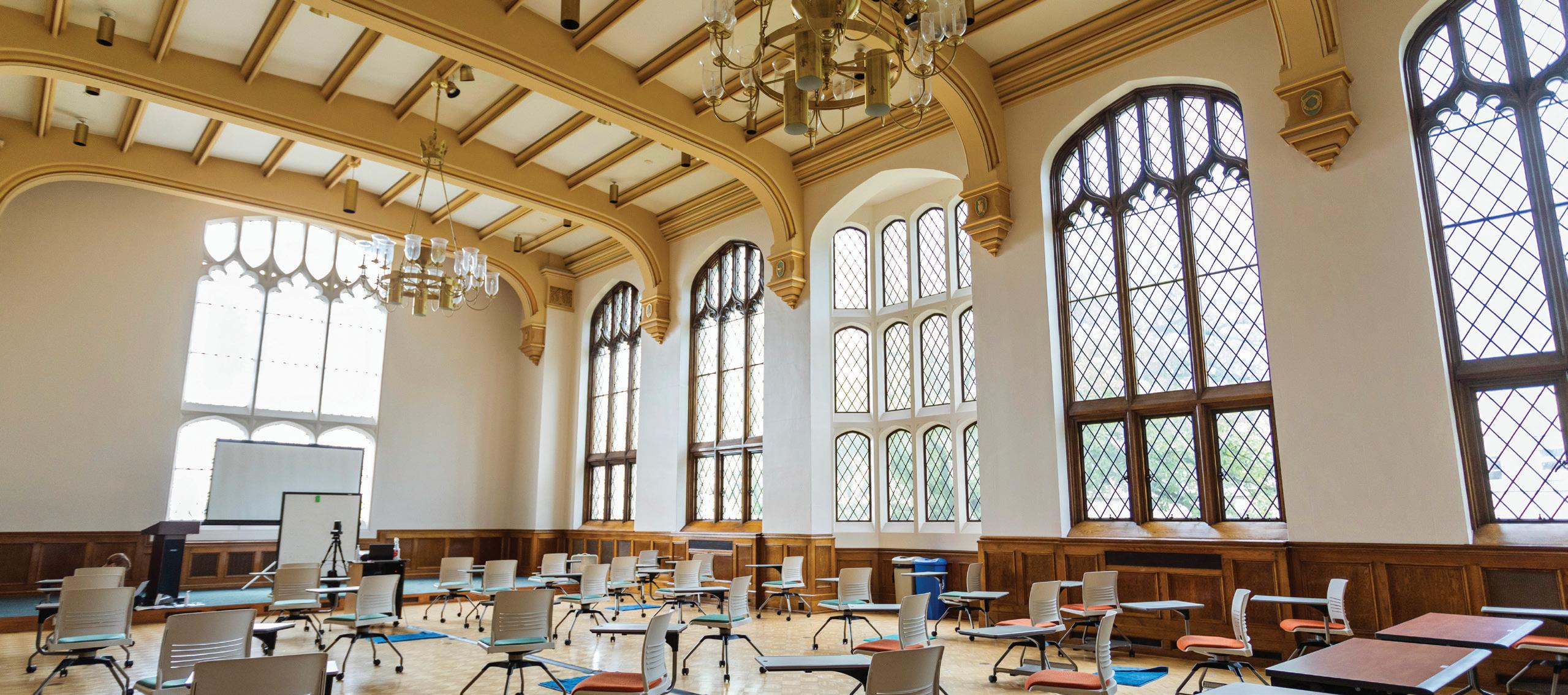
Stiemke Hall, one of the largest gathering rooms on campus, has been repurposed as a socially distant classroom.
INFORMATION TECHNOLOGY AND INSTRUCTIONAL DESIGN:
CONNECTING VIRTUALLY THROUGH HIGH-TECH CLASSROOMS Participatory, collaborative and active. Before the pandemic, these may not have been words some educators would have used to describe remote learning. But there’s been a discovery that online learning can be meaningful and productive, and Mount Mary faculty have been particularly creative in attending to the evolving situation that requires them to accommodate students in-person and remotely. Mount Mary has directed over $350,000 of COVID-19 relief funding to enhance the technology in all classrooms. Two classrooms are fully immersive, four now have enhanced technology and the remainder of the classrooms are equipped with cameras for remote/hybrid learning. Our IT department rose to the challenge and spent the summer upgrading classrooms and technology all over campus. How do some of these upgrades help faculty teach better? Here are a few ways:
Screens in the back of the classroom allow professors to see all students, including those participating from home.
Take a peek inside Mount Mary’s new high-tech classrooms: magazine.mtmary.edu
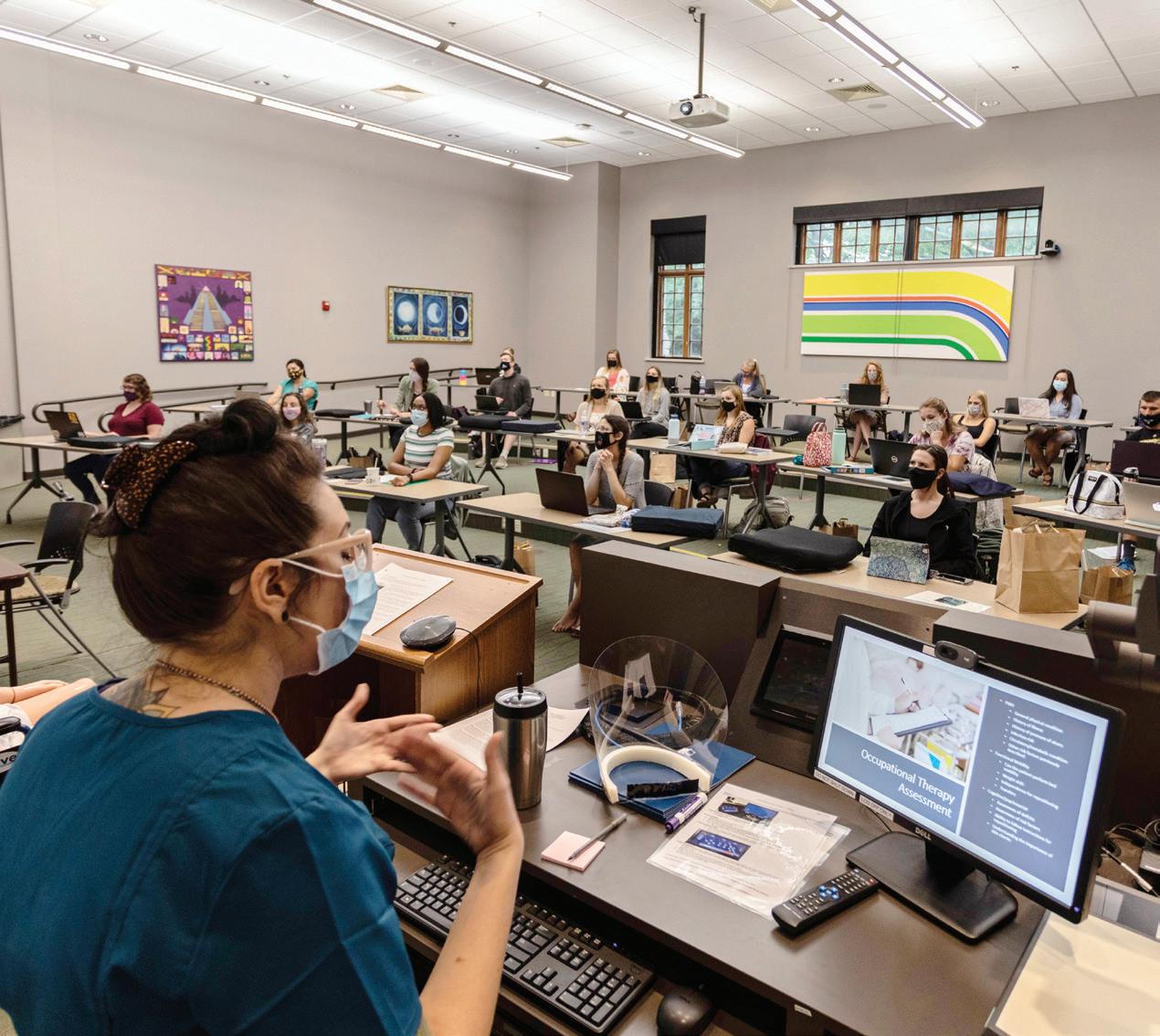
Microphones make it easier to deliver lectures that might otherwise sound muffled by face masks.
Tracking cameras focus on the teacher, even as she or he moves around the classroom.
Professors can use iPads to show close-up demonstrations and work, which can be projected on the screens in the classrooms or viewed remotely.
Integrated multimedia software makes the coursework easy to access for students.
Multiple monitors allow professors to display material for in-class and at-home viewing. John Futterer, Instructional Designer
STUDENT AFFAIRS:
CELEBRATING MILESTONES, DESPITE THE DISTANCE When we sent out a poll to our spring graduates asking them how they would like to celebrate their Commencement, they overwhelmingly asked us to postpone the ceremony until August, in hopes that we would be able to gather with one another “as normal.” As the summer months progressed, we knew that even an August ceremony would require strict social distancing measures. At the same time, we realized how important the experience would be for students who had worked so hard to don a cap and gown and walk across a stage and pick up their diplomas. I knew we had to find a way to honor their achievement. On a bright blue Saturday morning in August, we welcomed 95 graduates into the Alumnae Dining Room, which was carefully set up to accommodate the group. As each of their names were called, they walked across the stage, while their families witnessed the event on enormous screens set up in the parking lot outdoors, or livestreamed at home. It was the first drive-in commencement ceremony in Mount Mary history! I thank God for this moment of joy amid uncertainty, because it brought such happiness to graduates and deep satisfaction to me. I sometimes reflect upon what in my 25 years of higher education leadership prepared me to guide an institution through a pandemic. The answer is dichotomous, nothing and everything. My background in science taught me enough about infectious diseases to be dangerous. My teaching career taught me that uncertainty can lead to fear and great anxiety. An emergency planning meeting that happened to use the example of a pandemic taught me enough to know that the reality of the situation would be extremely complicated. Putting all these experiences all together I realized nothing seems certain. We are not out of the woods, so to speak, and we are in the process of determining what our December Commencement will look like. But I have learned that the collective efforts of people who care about each other bring sufficient clarity to focus on our goals and persevere until the day we can once again be physically together. And through the hard work of good people, and with tremendous faith in God, we have come a long way. Christine Pharr, Ph.D., President
Family members watched from their cars as graduates walked across the stage at the modified in-person Commencement ceremony held in August.


